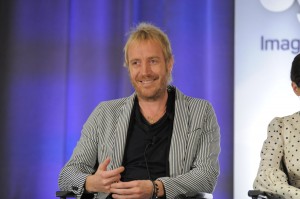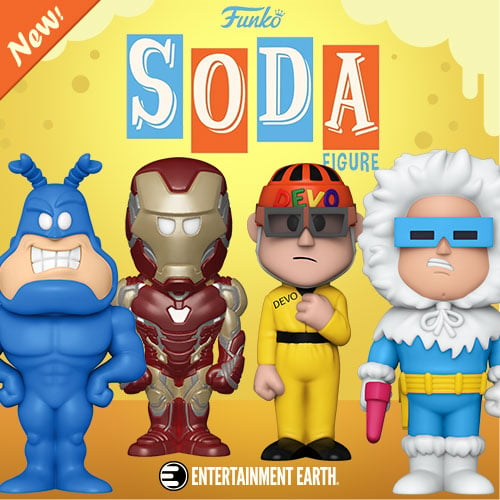Neverland is a Syfy original mini-series about the origin of Peter Pan. Set to air in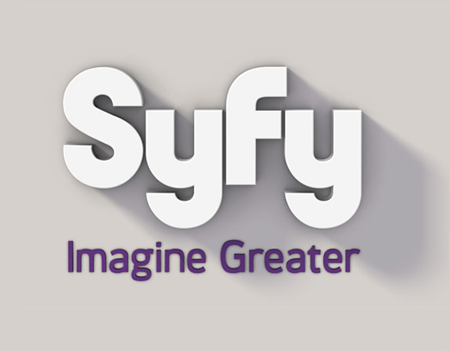 December on Syfy. Two weeks ago I was fortunate to participate in a panel interview of the stars of the series, Anna Friel (Captain Elizabeth Bonny), Rhys Ifans (James Hook) and Charlie Rowe (Peter).
December on Syfy. Two weeks ago I was fortunate to participate in a panel interview of the stars of the series, Anna Friel (Captain Elizabeth Bonny), Rhys Ifans (James Hook) and Charlie Rowe (Peter).
The series is a new approach to the J. M. Barrie classic which has been “Disney-fied” for the last half century or so and is more adult. The stellar cast includes Bob Hoskins reprising his role of Smee from the movie Hook.
The panel was led by Mark Stern, President of Original Programing for Syfy.
MARK STERN: All right. Let’s start the next panel, “Neverland.” We are very excited about this new, four-hour miniseries, which is going to be launching our countdown to Christmas week. It’s going to air Sunday, December 4th, and Monday, December 5th, at 9 p.m. That’s — I don’t think that’s new news, but I don’t care if I do.
Mark Stern had been playing tones all morning (Telephone app plays sounds of applause.)
Oh, stop it. “Neverland” is an origin story, actually. It’s about how the characters in J.M. Barrie’s classic became those characters. And it was directed — written and directed by Nick Willing, who you may know from “Tin Man,” our most successful miniseries ever, as well as he was the veteran director of “Alice.” So it’s an amazing, sweeping epic adventure. We are very, very excited about it, and it’s going to launch Christmas week. So let me bring out our cast. Please welcome Rhys Ifans, Anna Friel, and Charlie Rowe.
(Applause.)
ANNA FRIEL: Hello.
MARK STERN: So welcome, you guys. I think, before we get to questions, let’s watch some footage, actually.
(Clip shown.)
MARK STERN: So it’s just a little, teeny movie. So tell us — before we open it up to questions for these guys, I have a couple of my own. What was it like to be part of such a classic story? Was it daunting for you guys, or how did it feel to be involved in something like that?
RHYS IFANS: It wasn’t daunting. I mean, what’s daunting is, I guess, that we — that everyone knows the story of Peter Pan. And what was appealing, I guess, for all three of us is that this goes a long way, if not all the way, to explain how Peter Pan becomes Peter Pan, how he acquires these magical powers and how Captain Hook loses his hand.
ANNA FRIEL: I have a six-year-old daughter. She just went, “Mommy, there’s no way you can’t not do ‘Neverland.'” She was very excited. She wasn’t too happy about the idea that I might potentially kill Peter Pan. She thought that was stupid, but she was very excited about it.
CHARLIE ROWE: Yeah. No. I was pretty apprehensive because I, like, have quite big boots to fill. It was great fun, a completely different story to the original story. I think we did it justice.
ANNA FRIEL: Uh-huh.
MARK STERN: And, Charlie, I have to say it was really a mind-blowing performance for someone your age. How old are you?
CHARLIE ROWE: I’m 15. Thank you very much.
MARK STERN: Okay. To take on a roll that big is really impressive, if I do say so myself.
CHARLIE ROWE: Thanks.
MARK STERN: No. But I think — and what was it like to work with actors of that caliber?
CHARLIE ROWE: Yeah. I thought I am incredibly lucky to work with such great people and amazing actors. I learned a lot, particularly from Rhys and Anna. They are like my mother and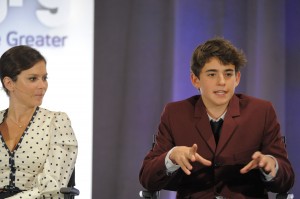 father on the set even though my mother and father were actually on the set, and I —
father on the set even though my mother and father were actually on the set, and I —
ANNA FRIEL: Big sister. Big sister.
CHARLIE ROWE: Yeah. I learned a lot — yeah, I learned a lot from them. Thank you.
ANNA FRIEL: You were an absolute pleasure. I think I’ve got a very bright star on the horizon sitting right next to me.
CHARLIE ROWE: Yeah.
MARK STERN: And, Anna, was that role — I mean, the role of a pirate queen, as it were, was it as much fun as it looked?
ANNA FRIEL: It was great fun. I just loved the costumes. I played Bonny. We decided to make her Irish with the accent. And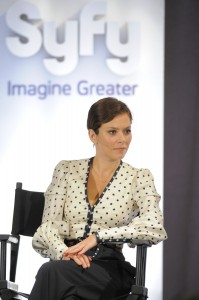 Nick, our director and writer, was just a joy to work with. I think we did about a three-and-a-half, four-month shoot, and never once did he complain of tiredness, and he kept the energy on the set all the time. It was great, although we worked with a lot green. Green became our least favorite color. I was like, “Oh, another green screen.” The effects are amazing. I have not seen it done to that degree.
Nick, our director and writer, was just a joy to work with. I think we did about a three-and-a-half, four-month shoot, and never once did he complain of tiredness, and he kept the energy on the set all the time. It was great, although we worked with a lot green. Green became our least favorite color. I was like, “Oh, another green screen.” The effects are amazing. I have not seen it done to that degree.
RHYS IFANS: It’s cool, huh?
CHARLIE ROWE: Yeah.
RHYS IFANS: Yeah. It was nice to use the imagination. We had these big boards that Nick showed us every day and said, “This green screen is going to look like this.” The whole imagination was suspended in disbelief. It was a good challenge.
MARK STERN: Yes.
CHARLIE ROWE: And Nick also said at the beginning of the shoot, “We are going to end exactly 7:00 on our last day.” And after 54 days of filming, we ended at two minutes to 7:00, and I was just like — that was just, like, the icing on the cake. That was awesome.
ANNA FRIEL: I was so jealous of your flying. I wish I could fly.
CHARLIE ROWE: Yeah. No. It has a lot you should be jealous of.
MARK STERN: Rhys, you have a very interesting character. Your character really starts — has to kind of navigate a good guy to a bad guy and back again. What was that like?
RHYS IFANS: Well, I mean, it’s thrilling, and that’s the beauty of a miniseries is that, in a film, you wouldn’t have the time that a miniseries offers to explore such complexities. And it is a real, kind of, roller coaster, model roller coaster, for Hook. So, you know, thank you for giving us time to do that.
MARK STERN: Oh, it was nothing. My pleasure. Shall we open up to — open up to questions? Okay.
QUESTION: Hi, Rhys. We’ve seen kind of a resurgence of fairy tales in movies and television lately, the Boochies and white phones that are coming out in multiple shows. Why do you feel that’s happening now? And do you feel that there are certain projects that have happened lately that have kind of paved the way for this?
RHYS IFANS: Well, you know, given this kind of fragile economic climate, you know, maybe there’s a need in all of us to escape to somewhere like Neverland where cash isn’t an issue.
ANNA FRIEL: Yeah. It’s one of the greatest stories ever written, and now, with all of the effects we have available, we want to see them retold and use those effects.
CHARLIE ROWE: Also —
RHYS IFANS: And — sorry. And I think these stories, you know, they come in waves, you know. It’s a title thing, you know, and there’s something kind of primal in all of these stories that speaks to everyone. That’s why we keep retelling them, revisiting them.
QUESTION: Rhys, mostly directed to you, but — and Charlie can answer, too. You’ve played a somewhat wide variety of characters on various movies. For this particular role of Captain Hook, was there any particular inspiration you drew from for this role, or did you just kind of develop it, you know, as a fresh character?
RHYS IFANS: No. Well, I mean, what intrigued me was — no. We all know the Hook that we were presented with in the novel, and that Hook is essentially bad to the bone. And I wanted to kind of explore a journey, you know. How would a man become that bad? What would it take for a man to shed pretty much all of his moral fiber when — and what happens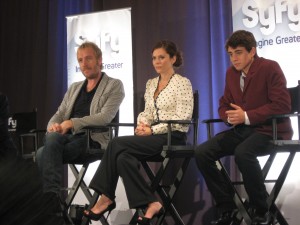 to the mind when it’s offered eternal life? Does it corrupt, or does it illuminate? In Hook’s case, it corrupts, but it also liberates him from a very, kind of, stifled, unrepressed Edward in England. Bonny liberates him completely and sexually, which wouldn’t have been the case in England. Men was scared of women, and women were scared of men.So it’s a kind of double-edged sword, and it’s an interestingquestion, you know. What’s the price of liberty? So that was all very, kind of, interesting to play.
to the mind when it’s offered eternal life? Does it corrupt, or does it illuminate? In Hook’s case, it corrupts, but it also liberates him from a very, kind of, stifled, unrepressed Edward in England. Bonny liberates him completely and sexually, which wouldn’t have been the case in England. Men was scared of women, and women were scared of men.So it’s a kind of double-edged sword, and it’s an interestingquestion, you know. What’s the price of liberty? So that was all very, kind of, interesting to play.
MARK STERN: And an interesting surrogate father-son relationship that you have —
RHYS IFANS: Yeah.
MARK STERN: — with Peter that kind of pays the price for that.
RHYS IFANS: Yeah. That kind of — that kind of changes. You know, that’s the kind of model dynamic, I guess, in the whole thing is our relationship, and as Charlie becomes — as Charlie is — Peter becomes better, Hook becomes worse.
MARK STERN: Right.
RHYS IFANS: Yes, I think it’s very moving, that whole dynamic.
MARK STERN: It really is. Any questions?
QUESTION: Hey, guys, thanks so much for taking the time. I’ve got a question about the action in the film because there are a lot of fighting scenes and action scenes. How much training do you actually have to do for the fencing and the sword fighting, if at all?
ANNA FRIEL: Go, Charles. What was it for fencing? You had a lot more, didn’t you?
RHYS IFANS: I’m just a natural.
ANNA FRIEL: Huh?
RHYS IFANS: I’m just a natural.
ANNA FRIEL: Yeah, you are a mighty fine fencer.
CHARLIE ROWE: No. We just — yeah. Me and Anna have had a lot of lunch breaks just trying to beat each other with swords, which was fun. And we did, like, long sessions on wires and stuff —
RHYS IFANS: Yes.
CHARLIE ROWE: — which is pretty exciting stuff. I mean, it’s every boy’s dream and every man’s dream. I shouldn’t say just a boy.
RHYS IFANS: Thank you.
CHARLIE ROWE: Every boy’s dream to fight. Sorry. We had a laugh, really.
RHYS IFANS: It’s great. You know, we did work quite intensely initially on the fighting, and you kind of just acquire the skill. So as the fights progressed in the film, we spent — because we were so — we became so adept early on, we spent kind of less and less time because we became, sort of, fighting with direction better, but also, you know, CGI helps.
CHARLIE ROWE: I think the whole shoot was pretty intense, but I think Nick, the director, just sort of made it a lot less and just a lot more — a very happy place, really. The pressure didn’t really get to us because Nick was just there, making us all feel good. He did a good job of it.
ANNA FRIEL: Yeah.
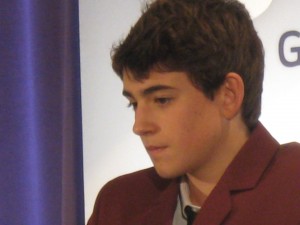 QUESTION: Hi. Good morning. I was just curious. Since there’s so much of Peter Pan out there and it’s kind of hard to avoid it growing up or being anywhere, how did you — like, what did you use for inspiration to try to make your characters unique, to try to make sure that we weren’t going through the same thing again, that you brought something totally different?
QUESTION: Hi. Good morning. I was just curious. Since there’s so much of Peter Pan out there and it’s kind of hard to avoid it growing up or being anywhere, how did you — like, what did you use for inspiration to try to make your characters unique, to try to make sure that we weren’t going through the same thing again, that you brought something totally different?
ANNA FRIEL: I think we’ve already been given that with a very unique script. It was a very different take on it. It was a prequel to Peter Pan. So you were already telling a different story. And, for me, it’s a new character. So I had a massive scope of choice of emotions and characteristics as to what to give her. There’s no Wendy. So that makes it — it makes it different from the first story. I don’t know. What —
CHARLIE ROWE: I tried to avoid watching “Hook” and all of thatbefore getting the part. I just tried to talk to Nick because I think — I think Nick — Nick Willing is Peter Pan, really. So I just tried to involve him into my part because I think — yeah, I think he’s still a child. If you meet him, he’s a complete child, and it’s his little baby, this film. And so I just tried to involve him as much as I can into the parts I was doing. And, yes, my part is basically just Nick, very honestly.
QUESTION: Good morning. This question is for Rhys. I’ve always felt personally that Hook is kind of a one-dimensional character. You gave him a lot more depth, and I didn’t think your approach was going from a good man to an evil man. It was more like a descent into madness. Would you say that was your approach?
RHYS IFANS: Yes, absolutely, and I think eternal — the question of eternal life — and I have much to think about it — it is maddening, but we’ve got madness coming — a freedom. But that freedom eventually corrupts, I think, and it is a descent into madness. You are right. And I’m glad you noticed that. Thank you.
QUESTION: Thank you.
QUESTION: Hi. Thanks so much for talking to us. I’m curious. Everybody looks at Peter Pan as a family type of story. How would you say that “Neverland” will resonate with yours?
RHYS IFANS: Well, it is a family — the original is very much a family story, and, you know, there are kind of dark, adult themes. And I think that is the appeal of the novel and the prequel, but it engages all ages. There’s questions of father-son and with a kind of union, Freudian sexual questions, you know. So there’s many kinds of emotional frets and dynamics that appeal to all ages, and particularly with “Neverland,” you know. When we read the novel, Hook and Peter are already embedded in Neverland. So I think what gives us another connection to Neverland is that we see them as — albeit in another time, but we see them as, you know, human beings who live in a world where you eventually die. So we see what the wonder of somewhere — in Neverland, somewhere like Neverland, what it does to the psyche. And in Peter’s case, it makes him good, and in my case, it makes me very, very bad.
ANNA FRIEL: And in my case, it makes me evil.
RHYS IFANS: Yeah.
QUESTION: Thank you.
MARK STERN: Well, Bonny is an interesting character because she actually has a whole different — she comes from a different time —
ANNA FRIEL: Uh-huh.
MARK STERN: — and has a different need and agenda, and into her life comes this kind of, like, new — it’s like when you’ve lived with the same people for a long, long time, and all of a sudden here come these new people to play with.
ANNA FRIEL: She’s also the only woman around for 20 years. She’s not had any other female company. So when Hook arrives, it’s fresh, new blood. He’s one who can bring her knowledge from another world.
female company. So when Hook arrives, it’s fresh, new blood. He’s one who can bring her knowledge from another world.
MARK STERN: Right.
ANNA FRIEL: I think she’s learned very manipulatively to letting her female — the power of her female prowess and how to use and abuse that.
MARK STERN: And it is interesting in the way that she comes between the father-son. It is this very, kind of, classic story of a woman that comes into a boy’s father’s life and what that does to that dynamic.
ANNA FRIEL: Yeah. I love the dark undertones of the story. I think it makes it very available for both children and adults.
MARK STERN: Yes.
ANNA FRIEL: I got both of those views from my daughter and from my mother and father. They enjoyed it for totally different reasons, and I think that’s why it’s so appealing, because it appeals to such a wide and varied audience.
RHYS IFANS: It’s also interesting, what you said, that it has that kind of stepmother theme-
ANNA FRIEL: Yes.
RHYS IFANS: — as well, which runs through so many fairy tales. I think another exciting, kind of, dynamic and an attitude is that we as humans in Neverland are the aliens.
MARK STERN: Right.
RHYS IFANS: So Bonny is essentially visited by a superior technological species which, again, you know, is a theme that runs through certainly a lot of sci-fi.
MARK STERN: That’s true. There’s a little alien in there, too. Any other questions? Okay. These guys will be down here for — I’m sorry. Did I miss someone? Yes. I’m sorry.
QUESTION: Obviously, “Neverland” is a prequel to “Peter Pan.” We’ve had that in the past with “Star Wars.” Is it true you are doing it with “Lord of the Rings”? What do you think makes movies like that where it’s so appealing to the audience?
ANNA FRIEL: Because the story is good to start with. You want to know what happened beforehand. That’s the only way you can go out and do sequel after sequel after sequel. I think we are intrigued about what happend before the story even started, and it seems to be — and I’ve followed others’ work thus far. And particularly with a story like Neverland, it has never been done before. Why can Peter Pan fly? Why is there eternal life? Why do you never grow old?
CHARLIE ROWE: Yeah.
ANNA FRIEL: It’s kind of like an age-old vampire story in a way.
CHARLIE ROWE: Every kid in the world has grown up with these unbelievable stories, and everyone has their own different idea of why and how they got there. And that’s why I think it’s great that we’ve got all of these different ones like “Wicked” and now “Neverland,” you know, coming up because it’s basically someone’s complete imagination. It’s — everyone has got a different idea of why they are there.
MARK STERN: Great. One more in the back, way back.
QUESTION: Good morning. I have one quick — a couple quick questions. First off, the scenery looks beautiful. I know a lot of it was shot on a chromakey green screen, that type of thing, but can you go into the locations of the shoot, how long it took to shoot, how many people were involved in the whole process for this series?
ANNA FRIEL: We started off in Italy, and that was the most exciting part of the shoot for me. Was it for you, to be shot in a real boat?
CHARLIE ROWE: I had been there for ages as well. I did a film about pirates in the 1800s as well. 1900s. Excuse me.
ANNA FRIEL: Yes. Wasn’t it plastics —
CHARLIE ROWE: Yeah.
ANNA FRIEL: — the pirates they used for that?
CHARLIE ROWE: Yeah, the pirates.
ANNA FRIEL: And it still sits there today. We didn’t, obviously, take it out to sea. It was moored, but it was a spectacular thing to look at.
CHARLIE ROWE: Yeah. It was quite amazing.
ANNA FRIEL: Yeah. The skies are the motor boat, a great big green screen. I loved that. When we were in Genoa, Italy and then Ireland for the rest of it —
CHARLIE ROWE: Yeah.
ANNA FRIEL: — so two really remarkable locations with fantastic crews.
RHYS IFANS: A lot of the exteriors were, you know — such as the Indian reservation or the Indian lands were shot in Parkland in Ireland. The London stuff, the exterior stuff, was shot in Dublin, which has a lot of Georgian architecture, which would have suited. And then “Neverland” ironically was filmed in a disused toilet paper warehouse just outside Dublin.
MARK STERN: So romantic.
RHYS IFANS: Yeah.
ANNA FRIEL: Yeah, but what you can do with computers nowadays, eh?
MARK STERN: I would say that there is probably a visual effects or enhancement in almost every single shot of this miniseries. It is really quite extraordinary. Okay. Well, thank you very much. These guys will be down here for the next 10 minutes or so to talk to you. Thank you, guys.
ANNA FRIEL: Thank you.

